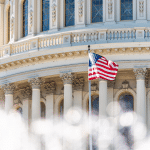COVID-19 CHECKLIST FOR EMPLOYERS
Revised 4/27/2021
The COVID-19 pandemic has changed how we work. Employers have a responsibility to protect employees and must adapt to meet safety challenges faced during the pandemic. While working to protect the health of their employees and their business, employers must also remain in compliance with rapidly changing federal, state and local regulations.
Use our checklist to guide and organize your response as an employer.
WORKPLACE SAFETY
Define the measures you’re taking to protect the health of your employees, using CDC and OSHA guidance for businesses and workplaces. On January 29, 2021, OSHA released new guidance with recommended safety standards and steps to limit the spread of COVID-19 in the workplace.
- Cleaning and disinfecting procedures. Expanded cleaning specific to your worksite and industry.
- Physical distancing practices, such as staggered shifts, changes in seating/workstations, defining protocols for meetings and contact with customers, visitors and clients.
- Health screening policies such as temperature taking.
- Personal protective equipment for employees, such as masks and hand sanitizer.
EXPOSURE RESPONSE PLAN
Establish the procedures you will follow when an employee tests positive for COVID-19. For more detailed recommendations, visit our blog What to Do When an Employee Has Covid.
- Contact tracing. If an employees tests positive, identify all individuals the employee came into close contact with and immediately send these employees home. The CDC defines a close contact as someone who was within six feet of an infected individual for a total of 15 minutes or more over a 24-hour period.
- Employee quarantine/stay-at-home requirements. The CDC updated its guidance for how long individuals who tested positive should quarantine at home, shortening from 14 to 10 days for those with mild symptoms. The CDC also updated its guidance for those who were exposed. An exposed employee may end quarantine after seven days if the employee has no symptoms and receives a negative test on the fifth day of quarantine or later
- Employee return-to-work procedures. The CDC has also updated its guidance on testing, no longer recommending that two negative tests are needed before employees return to work.
- Communication to affected employees. How will you let employees know about possible exposure while protecting employee privacy and confidential medical information?
EMPLOYEE HANDBOOK
Update your handbook with new and revised policies adopted in response to the pandemic.
- Infectious Diseases Control Policy that summarizes steps you are taking to prevent the spread of infectious diseases in the workplace.
- Paid leave policy changes. This includes Emergency Paid Sick Leave and expanded FMLA policies created under the Families First Coronavirus Response Act (FFCRA) for employers with fewer than 500 employees. (FFCRA expired Dec. 31, 2020 but employers who still offer FFCRA paid leave through September 30, 2021 can be reimbursed through payroll tax credits.)
- Temporary telecommuting policies or flexible scheduling options offered to employees.
- Workplace vaccination policy. Devise a clear vaccination policy that fits the needs of your workplace. Read the Anthros team’s answers to vaccination FAQs.
COMPLIANCE
Employers should review new programs and regulations established by COVID relief legislation, such as the Paycheck Protection Program and Employee Retention Tax Credit. With increased furloughs, layoffs and recalls, employee documentation needs have also increased.
- Paycheck Protection Program (PPP). Employers who received a forgivable PPP loan must use at least 60% of the loan on payroll to be eligible for loan forgiveness. The new COVID relief bill passed in December 2020 expanded the PPP, and some businesses may be eligible for a second loan. Read our team’s summary of the new legislation.
- Forms to document employee leave requests for Emergency Paid Sick Leave and expanded FMLA created under the Families First Coronavirus Response Act (FFCRA). FFCRA expired December 31, 2020; however, employers who voluntarily continue to offer paid FFCRA leave through March 31, 2021 will be reimbursed through payroll tax credits.
- New hire/rehire paperwork and reporting. Gather new hire documents including I-9s and W-4s and confirm exempt vs. nonexempt status. Report to state agencies.
- OSHA recording and reporting procedures. Employers must record all work-related cases of COVID-19. They must report hospitalizations if the employee is hospitalized within 24 hours of being exposed at work, and fatalities if the employee dies within 30 days of exposure at work. Recording is an internal employer process; reporting means an incident is directly reported to OSHA. Review OSHA’s guidance on recording and reporting COVID-19 cases among employees. We are watching this issue closely as OSHA may issue new enforcement guidelines under the Biden administration.
- Federal and State compliance notices. Under certain laws such as FMLA and FLSA, employers are required to post notices in the workplace letting employees know about their rights. If your workforce is remote, review the Department of Labor’s guidance on electronic notification.
EMPLOYEE BENEFITS
Review changes in eligibility and coverage and consider what mental health tools and resources you can make available to employees. Learn more about supporting employee wellbeing in a pandemic.
- Resources for employees dealing with stress, anxiety and change, such as the Anthros Employee Assistance Program.
- Telehealth benefits or virtual healthcare options. If your group health plan does not offer this, consider a standalone telehealth benefit such as Anthros’ Doctegrity telemedicine benefits so employees get the care they need.
- Group Health Insurance. Review eligibility requirements related to layoff or furlough. (The Affordable Care Act requires employers to reinstate employees to the plan if removed from the plan for less than 13 weeks.)
- 401(k) plans. Review eligibility requirements related to layoff or furlough. Understand new rules established under the CARES Act about hardship withdrawals for employees affected by COVID-19.
Anthros continues to help clients navigate the complexities of being an employer during the COVID-19 pandemic. We provide our clients assistance with compliance, PPP reporting, leave forms, handbook policies, communication templates, new hire documentation and reporting. Please do not hesitate to reach out to the Anthros team for assistance.















